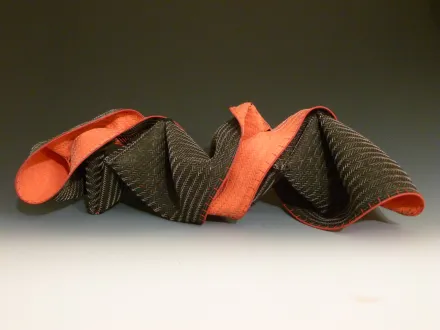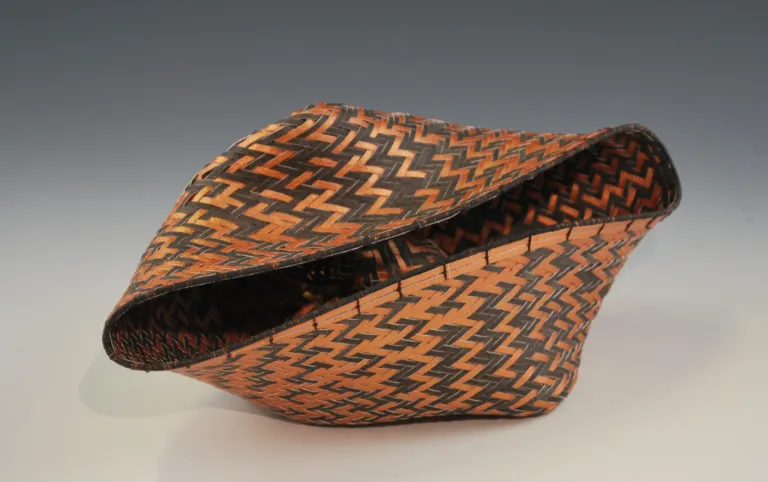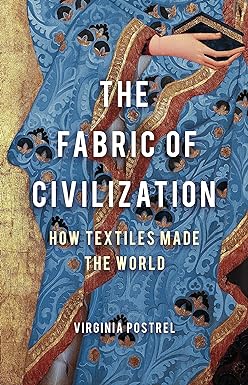
Send your news items to Tim Prins by the 25th of the month for inclusion in the next month’s newsletter.
Guild Calendar
Thursday, February 8, 2023 – February Meeting
Multnomah Arts Center + Zoom, 7688 SW Capitol Hwy. (503) 823-2787
10:00 am Day Meeting – Auditorium
9:30 am – 10:00 am: Set up, social time and library browsing time
10:00 am – 12:00: Meeting
7:00 pm Evening Meeting – Auditorium
6:30 pm – 7:00 pm: set up, social and library browsing time
7:00 pm – 9:00 pm: Meeting
Wednesday, February 21, 2023 – Board Meeting
Tentative date, see website for updates
7:00 pm – 8:30 pm – Zoom
Thursday, February 22, 2023 to Sunday February 25 – Guild Retreat
Cedar Ridge Retreat and Conference Center, Vernonia, OR
President’s Message
Billy and I belong to a book club. It started out as a science fiction book club, but over the years it’s strayed into fantasy now and again. This month’s book (Nettle & Bone by T. Kingfisher) features a protagonist who is a fiber person. She does embroidery work but also spins and understands weaving. Tapestry comes into play for part of the story, and early in the book one of her tasks is to spin thread to use in making a cloak. It’s surprising what a little connection like that can mean. I was quickly drawn into the character in part because of that one trait. Of course, it’s one of the reasons why guilds exist and continue to thrive, even in the internet age. That shared knowledge provides an instant connection that allows other, deeper connections to form and grow. No wonder that so many of us count fellow fiber artists among some of our best friends.
I hope you’ll all take advantage of the opportunity to expand your own circle of fiber friends by joining one of the study groups that are starting to form. If you need more info ask Linda Edquist. As the groups start to take shape we’ll add them as a resource to the website, and we’ll try to include a list of the current groups in the newsletter.
Lastly, speaking of newsletters, ANWG is in need of a new newsletter editor. Sylvia Emard, a long time PHG member, is ready to hand over the reins to someone else. If you are interested, or know of someone who would be a good fit for that role, please let me know and I’ll pass it along. The ANWG newsletter comes out quarterly, so it’s not as demanding as the usual monthly newsletter that groups usually do.
That’s it for now. As always, I hope to see you at a meeting soon.
Dan
Upcoming Programs
February 8: Giovanna Imperia Presents Two Programs
In February, we will have two different programs presented by Giovanna Imperia at the morning and evening meetings. The morning program is “Weaving with Crepe and Elastic Yarns”. The evening program is “Weaving with Metallic Yarns”. The presentations will be by Zoom and the meetings remain hybrid so we can still gather for fellowship, sharing, and library or rental access. Both programs will be recorded and available to members for a limited time.
Weaving with crepe and elastic yarns
Crepe and elastic yarns are what many weavers consider energized or active yarns — yarns that will move during and after the weaving process. Unlike “regular” yarns, crepe and elastic yarns seem to have a life of their own, and have the ability to transform fabric from a flat, two-dimensional surface to a textured 3D fabric.
In this presentation, we will discuss the unique properties of crepe and elastic yarns and how to harness their innate energy to create pleats, bumps and all sort of 3D textures.
We will also discuss the differences not only between crepe and elastic yarns, but also within each group of yarns. We will address a number of questions such as are all the elastic yarns the same? Are there any differences between S and Z crepe yarns? And much more.
Weaving with metallic yarns
Oftentimes, when we think of metallic yarns, we assume we are dealing with metal. In fact, the terms “metal” and “metallic” are sometimes used interchangeably. However, in this presentation, we will focus on those yarns that are manmade and are intended to have the appearance of metal. Some of these yarns do actually contain some metal, but the vast majority just look like they do. Depending on how they are constructed, metallic yarns can have interesting properties: some may be energized, others my shrink, and so on. This presentation will touch on some of the basic differences between metallics and review how they can be effectively used in weaving.
March 14: From Baskets to Sculptures – Dorothy McGuinness



Dorothy McGuinness will discuss her basket making journey of learning all she could about basket making techniques and materials. She will talk about her switch to paper as a weaving medium and her utilization of the diagonal twill technique to transform her work into sculptural forms.
Guild News
Consider Joining the Guild Booth at The Gathering of the Guilds!
We have plenty of space in the Portland Handweavers Guild Booth at the Gathering of the Guilds, April 19-21, 2024 at the Oregon Convention Center. Your investment is time and PHG will collect a commission on sales you make during the sale. It is a great option if you don’t want to get your own booth space but space is limited to 10 vendors so sign up to get a spot.
But if you do want a space we are down to our last few booths. You could get a 10×10 or 10×15 or a portion of a booth. All of the information you need to know and the applications HERE and on our website. The Spring Sale is also PHGs fundraiser the proceeds of which allows us to host our monthly meetings and host the incredible speakers.
PHG Retreat – Last Call
We squeezed in this last reminder for the Annual Portland Handweavers Guild Spring Retreat 2024!
There is still room for YOU to join in on the fun. Previous Newsletters detail all the pertinent information. Sooo, here’s what you need to do now. The official deadline for Registering is February 1, 2024 but we will accept a postmark by that date.
See below for more information and how to signup
Library and Rental News
This fall, when a member returned one of our rental table looms she asked me if I knew that one of the reeds for the loom was a little too long to fit in the beater. “No,” I replied. The reeds had come with the loom. I had just assumed that they all fit. Apparently, it had never been used by the previous owner. “No worries,” I said, “I’ll just cut it down.”
I took the reed and the beater home in order to cut it down. Before starting I decided I should look online to find out how I should go about cutting it down. I knew that reeds could be cut down but had never actually tried it myself. In my search, I found a YouTube video from the Eugene Textile Center about cutting down reeds. The video didn’t cover my immediate concerns as the reed needing to be shortened was one of the newer welded style reeds rather than the older tape covered ones that we have with our floor looms, but I decide to watch it anyway. I saw that it wasn’t that difficult to cut that kind of reed down. More interestingly, I saw how the reed was put together.
The dents of the reed are placed between two half rounds of wood. String is then wound around the half rounds of wood to hold them together and to space the dents. I had always heard that you should put duct tape over the edges of the reed if the paper had been damaged. I never understood how the stainless steel dents would be protected by the tape. It’s not to protect the dents per se, it’s to protect the cord that is holding the dents in place. Needless to say, I immediately went to inspect my reeds and then ordered some hot pink duct tape.

A: wires or dents
B: wooden ribs
C: tarred cord
(Diagram from “Reed (weaving).” Wikipedia)
I did get the reed in question trimmed. I took out my Dremel tool and used a cutting disk until my husband decided I was having too much fun with power tools and took over.
Robin
Book Highlight
This month’s book highlight is by Nora Fairley. She started weaving in 2001 and loved it from the beginning. It was one of the drivers for her when she retired in 2009. Nora started with classes at MAC and still takes them. Within a couple years she joined the guild and has been working with the library for several years.
Nora is the second member to write a review for “The Fabric of Civilization: How Textiles Made the World”. Two members were inspired to write reviews of this book – a sign that maybe you would enjoy reading it as well!
THE FABRIC OF CIVILIZATION How Textiles made the world by Virginia Postrel

The author is a journalist known for her research. To encompass this topic she took up weaving to inform herself. Her thesis is civilization is illuminated by the story of textiles. From the beginning we wanted covering for protection and adornment and sought it through fiber or furs.
She headed her chapters: Fiber, Thread, Cloth, Dye, Traders, Consumers, and Innovators. Then we are off on a romp through history. Axes and spears were blades attached to handles by string which rotted over time. Thus what we call the stone age could have easily been the string age. Language is suffused with weaving terms. Knossos on Crete was a textile superpower. Even the myth of the Minataur in which Theseus unwound a ball of thread to return from the labyrinth supports this.
Humans cultivated cotton and bred sheep for wool making small progressive modifications over hundreds of years. Silk farmers grafted different species of mulberry trees together and pruned to enhance leaf production. These additive changes lead to more usable fiber.
Agostine Bassi studied a disease of silkworms and arrived at germ theory. His studies helped inform Louis Pasteur when France asked him to investigate another disease of the caterpillars. He learned to recognize and then isolate the sickened silkworms. This was his introduction to working with animals, veterinary science and then medicine.
The spindle was the first wheel. Not load bearing, it still introduced circular motion. Women all over the world were spinning to get fiber for weaving. Keeping enough fibers for weaving was a challenge. Mathematicians have suggested weaving may have been the basis for developing arithmetic. The loom, as we know, was the forerunner of the computer.
Dyes led to colored cloth which became highly valued. The dyers learned chemistry and chemists learned dye making. William Perkin doing chemistry experiments unexpectedly produced mauve, the first synthetic dye. Then many enjoined the effort to produce more.
In trade bolts of cloth were used as actual currency in China, Iceland, and west Africa as well as Europe. This lead to using bills of exchange that were used for loans. The trust was in the signatures. Middlemen developed. At first called factors, they were later called traders. Many textile merchants became bankers for example Lehman brothers.
Consumers changed the world. The Moguls who used furs desired cloth. Conquests were spurred by desire for fine fabrics eg silk in china. After they controlled areas to the west, they moved many weavers east. There developed a large technical and artistic exchange. Trade routes were established and protected.
Wallace Carothers, an organic chemist was trying to solve issues with long chain molecules and invented nylon, a long chain of esters hence polyester. Nylon stockings were a huge hit. Subsequent research has led to many materials innovations such as microfiber. We’ve learned to expect advances in our clothing materials. More are in the works even antibacterial.
In summary this is a huge topic with many examples. It increases your awareness of past development and the fantastic future. Much has been left out of this report. Dive in and prepare for a veritable feast.
Upcoming Workshops and New Chair Needed
Dianne Totten will be teaching Crimp and Create, Sept 13-15, 2024. I have again requested the gym because Dianne will take up to 30(!!!) participants. Details on the website eventually; it is way too early to sign up, and I can’t really price it until closer to the date because airfare…
I am finalizing contracts with Francisco Bautista (Rug Weaving), and Amy Belgan (Novice Tapestry Weaving) for April and May 2024.
This is my last year as Workshop Chair; I will stay on through the completion of the workshops above, but I will not be scheduling any more workshops for PHG.
Should anyone want to volunteer, the job description is on the Guild website (you’ve got to log in first): https://portlandhandweaversguild.org/members-only/the-drafts/job-descriptions/
I find some knowledge of spreadsheets helpful for keeping track of costs.
I will happily mentor my successor.
Cheers,
Lynne F
Latest ANWG Newsletter
The Association of Northwest Weavers Guilds has posted their January 2024 newsletter. Check out the creative ways other Northwest weaving guilds are getting their members together for fiber activities. All ANWG newsletters are available here.
News from Complex Weavers
The next Complex Weavers seminar will in Wichita, Kansas in 2024 alongside Convergence, including workshops by Karen Donde the new Complex Weavers President. The next Complex Weavers Journal is already at the printers and those of you who have already paid dues should receive it eventually
If you any questions please feel free to talk to me at the next meeting or reach out. Ladella Williams LadellawilliamsCZZ@gmail.com or text message to 503 729 1704
Bulletin Board
Ruthie’s Weaving Studio is looking for looms
Ruthie’s Weaving Studio would like to purchase two floor looms meeting the following criteria:
- 4 shafts and 6 treadles
- counter balance or jack
- weaving width between 20 and 27 inches
- folds when not in use
- great condition
- close to Portland
Please contact Janis Johnson at janis.marie.johnson@gmail.com.
Looking to Buy or Sell Weaving Equipment or Materials?
Check out the Items for Sale page.
Fiber News and Events
Red Alder Fiber Arts Retreat
February 15-18, 2024
Tacoma, WA
Register now: redalderfiberarts.com/
Whidbey Weavers Guild Annual Spin-In
April 6-7, 2024
Oak Harbor, WA
For more information, go to whidbeyweaversguild.org
Conference of Northern California Handweavers
April 25 – 28, 2024
Rohnert Park, California
More info: https://www.cnch.org/conferences/
Fiber in the Forest
May 17-19 2024
Camp Myrtlewood, OR
More info: www.eugenetextilecenter.com/fiber-in-the-forest
Fiber Fusion
June 3-4, 2024
Monroe, WA
More info: www.fiberfusion.net/
Black Sheep Gathering
June 28-30, 2024
Linn County Events Center in Albany, OR
More info: blacksheepgathering.org
Convergence
July 11-17, 2024
Wichita, Kansas
More info: https://weavespindye.org/convergence/
ANWG 2025 Conference
June 16-21, 2025
Yakima, Washington
More info: https://anwgconference.org/
Handweavers Guild of America
Textiles & Tea
Tuesdays
The Handweavers Guild of America, Inc.’s (HGA) exciting new program, Textiles & Tea, takes place every Tuesday at 4 PM (ET). We’ve invited some of the most respected fiber artists in the field today to join us for an hour long conversation where we will discuss their artwork and their creative journey. Make a cup of your favorite tea and join us as we talk about fiber, creativity, inspiration, process and so much more.
Rental Equipment
PHG has equipment available for rent to current PHG Members. Click here for more info.
PHG Board and Chairs
Please click here for a list of PHG Board Members and Committee Chairs.
Your purchases can benefit PHG! Click on one of these links before buying and PHG will earn a commission from your purchase.

Connect with the handweaving world through Handwoven. Every issue is packed with projects, instruction, and inspiration to help you build technical skills and design confidence.

The Woolery is the place for weaving, spinning, felting, dyeing, rug hooking and knitting. Established in 1981, our extensive inventory of products, excellent customer service and in-house fiber arts experience make us the ideal source for all your fiber arts needs. We have one of the largest selections of weaving loom and spinning wheel floor models for you to test drive. Your Fiber Journey Starts Here!”
